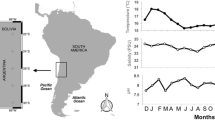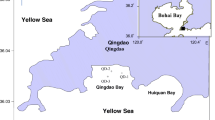Abstract
We attempted to propagate Macrocystis integrifolia (giant kelp) by fragmentation and regeneration of holdfasts, which consist of creeping stolons with lateral haptera. Stolons from a natural kelp population in Bahia Chasco (Atacama, North Chile) were cut into fragments, each containing one or more lateral stipe and frond initials. Fragments were attached to longlines with elastic bands. We used two additional types of inoculants as controls: (1) natural recruits from the local parent population and (2) laboratory-cultured young sporophytes. Length, reproductive phenology, and mortality were determined monthly. Our results confirmed the feasibility of M. integrifolia propagation by reattachment of stolon fragments, and we obtained up to eight new individuals from one parent holdfast. Individuals from holdfast regeneration formed sporangial sori 3 months earlier than control specimens from recruits and laboratory culture, while all three types gave similar values for mortality. Holdfast morphology of regenerates differed strongly depending on their origin: stolon fragments continued growth and developed new haptera except in the cut surfaces, natural recruits formed typical M. integrifolia holdfast morphs, and sporophytes originating from laboratory culture produced minor stolons with many haptera. Implications of our results on ecology, repopulation, and aquaculture are discussed.


Similar content being viewed by others
References
Correa J, Beltran J, Buschmann A, Westermeier R (1999) Healing and regeneration responses in Gigartina skottsbergii (Rhodophyta, Gigartinales) optimization of vegetative propagation for cultivation. J Appl Phycol 11:315–327
Correa JA, Lagos N, Medina M, Castilla JC, Cerda M, Ramirez M, Martinez E, Faugeron S, Andrade S, Pinto R, Contreras L (2006) Experimental transplants of the large kelp Lessonia nigrescens (Phaeophyceae) in high-energy wave exposed rocky intertidal habitats of northern Chile: experimental, restoration and management applications. J Exp Mar Biol Ecol 335:13–18
Demes KW, Graham MH, Suskiewicz TS (2009) Phenotypic plasticity reconciles incongruous molecular and morphological taxonomies: the giant kelp, Macrocystis (Laminariales, Phaeophyceae), is a monospecific genus. J Phycol 45:1266–1269
Gómez I, Westermeier R (1991) Frond regrowth from basal disc in Iridaea laminarioides (Rhodophyta, Gigartinales) at Mehuín, southern Chile. Mar Ecol Prog Ser 73:83–91
Graham MH (2008) Integrated culture of seaweeds and red abalone in Monterey Harbor. Final Project Progress Report, California Sea Grant College Program, UC San Diego p. 4
Graham MH, Vasquez JA, Buschmann AH (2007) Global ecology of the giant kelp Macrocystis: from ecotypes to ecosystems. Oceanogr Mar Biol Annu Rev 45:39–88
Hoffmann A, Santelices B (1997) Flora Marina de Chile Central. Ediciones Universidad Católica de Chile, Santiago, p 424
Lobban CS (1978) The growth and death of the Macrocystis sporophyte (Phaeophyceae, Laminariales). Phycologia 17:196–212
Macaya EC, Zuccarello GC (2010) DNA barcoding and genetic divergence in the giant kelp Macrocystis (Laminariales). J Phycol 46:736–742
Macchiavello J, Bulboa C, Edding M (2003) Vegetative propagation and spore recruitment in the carragenophyte Chondracanthus chamissoi (Rhodophyta, Gigartinales) in northern Chile. Phycol Res 51:45–50
North WJ (1971) The biology of giant kelp beds (Macrocystis) in California: introduction and background. Nova Hedwigia 32:1–68
Pacheco-Ruiz I, Zertuche JA, Espinoza J (2005) The role of secondary attachment disc in the survival of Chondracanthus squarrulosus (Rhodophyta, Gigartinales). Phycologia 44:629–631
Santelices B (1990) Patterns of reproduction, dispersal and recruitment in seaweeds. Oceanogr Mar Biol Ann Rev 28:117–276
Smith CM, Walters LJ (1999) Fragmentation as a strategy for Caulerpa species: fates of fragments and implications for management of an invasive weed. Mar Ecol 20:307–319
Westermeier R, Möller P (1990) Population dynamics of Macrocystis pyrifera (L.) C. Agardh in the rocky intertidal of southern Chile. Bot Mar 33:363–367
Westermeier R, Gómez I, Rivera PJ (1993) Suspended farming of Gracilaria chilensis in Cariquilda River, Maullín, Chile. Aquaculture 113:215–229
Westermeier R, Patiño DJ, Piel MI, Maier I, Müller DG (2006) A new approach to kelp mariculture in Chile: production of free-floating sporophyte seedlings from gametophyte cultures of Lessonia trabeculata and Macrocystis pyrifera. Aquacult Res 37:164–171
Westermeier R, Patiño DJ, Müller DG (2007) Sexual compatibility and hybrid formation between the giant kelp species Macrocystis pyrifera and M. integrifolia (Laminariales, Phaeophyceae) in Chile. J Appl Phycol 19:215–221
Westermeier R, Patiño DJ, Murúa P, Müller DG (2011) Macrocystis mariculture in Chile: growth performance of heterosis genotype constructs under field conditions. J Appl Phycol 23:819–825
Westermeier R, Patiño D, Murúa P, Quintanilla JC, Correa J, Buschmann A, Barros I (2012a) A pilot-scale study of the vegetative propagation and suspended cultivation of the carrageenophyte alga Gigartina skottsbergii in southern Chile. J Appl Phycol 24:11–20
Westermeier R, Patiño D, Murúa P, Muñoz L, Ruiz A, Atero C (2012b) Manual de repoblamiento de Macrocystis integrifolia en la región de Atacama. Proyecto FIC FNDR 2010 Región de Atacama. Universidad Austral de Chile. pp. 47
Acknowledgments
We thank C. Soza for the support in field studies. Financial support was provided by Regional Government of Atacama, in the context of FIC 2010 grant “Repoblamiento de Macrocystis integrifolia en la region de Atacama,” awarded to R.W. Valuable remarks from two anonymous reviewers and the hospitality of the Bahia Chasco fishermen are also acknowledged.
Author information
Authors and Affiliations
Corresponding author
Rights and permissions
About this article
Cite this article
Westermeier, R., Murúa, P., Patiño, D.J. et al. Utilization of holdfast fragments for vegetative propagation of Macrocystis integrifolia in Atacama, Northern Chile. J Appl Phycol 25, 639–642 (2013). https://doi.org/10.1007/s10811-012-9898-x
Received:
Revised:
Accepted:
Published:
Issue Date:
DOI: https://doi.org/10.1007/s10811-012-9898-x




